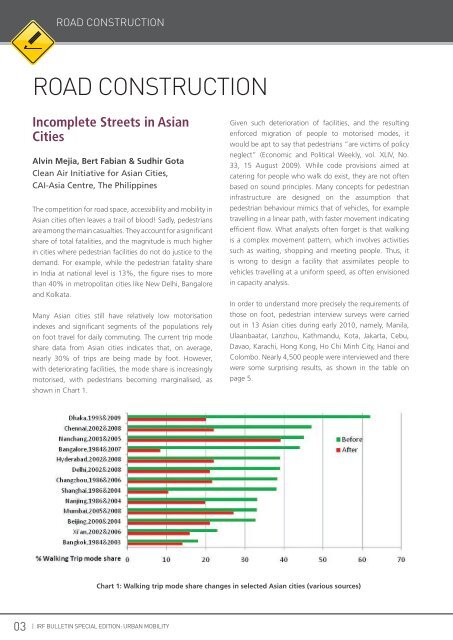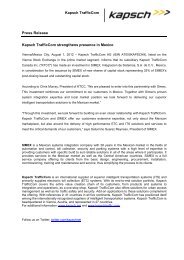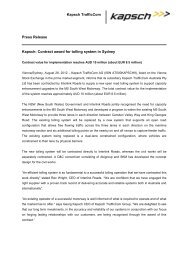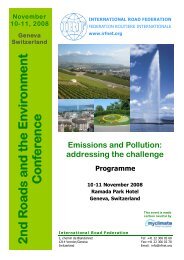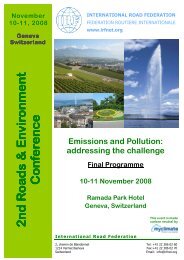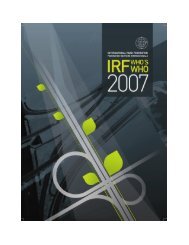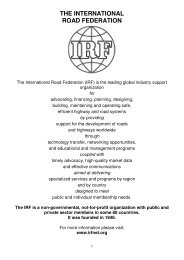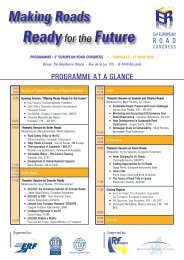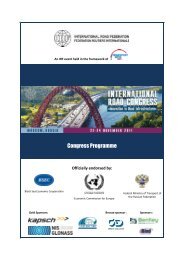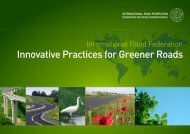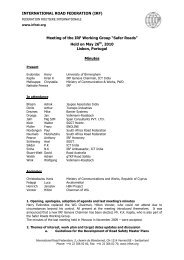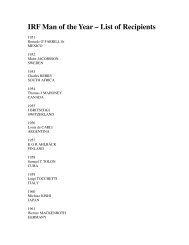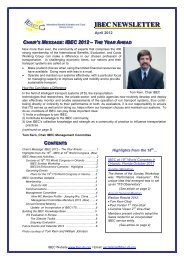Motorways and Urban Mobility - International Road Federation
Motorways and Urban Mobility - International Road Federation
Motorways and Urban Mobility - International Road Federation
You also want an ePaper? Increase the reach of your titles
YUMPU automatically turns print PDFs into web optimized ePapers that Google loves.
03<br />
ROAD CONSTRUCTION<br />
ROAD CONSTRUCTION<br />
Incomplete Streets in Asian<br />
Cities<br />
Alvin Mejia, Bert Fabian & Sudhir Gota<br />
Clean Air Initiative for Asian Cities,<br />
CAI-Asia Centre, The Philippines<br />
The competition for road space, accessibility <strong>and</strong> mobility in<br />
Asian cities often leaves a trail of blood! Sadly, pedestrians<br />
are among the main casualties. They account for a significant<br />
share of total fatalities, <strong>and</strong> the magnitude is much higher<br />
in cities where pedestrian facilities do not do justice to the<br />
dem<strong>and</strong>. For example, while the pedestrian fatality share<br />
in India at national level is 13%, the figure rises to more<br />
than 40% in metropolitan cities like New Delhi, Bangalore<br />
<strong>and</strong> Kolkata.<br />
Many Asian cities still have relatively low motorisation<br />
indexes <strong>and</strong> significant segments of the populations rely<br />
on foot travel for daily commuting. The current trip mode<br />
share data from Asian cities indicates that, on average,<br />
nearly 30% of trips are being made by foot. However,<br />
with deteriorating facilities, the mode share is increasingly<br />
motorised, with pedestrians becoming marginalised, as<br />
shown in Chart 1.<br />
| IRF BULLETIN SPECIAL EDITION: URBAN MOBILITY<br />
Given such deterioration of facilities, <strong>and</strong> the resulting<br />
enforced migration of people to motorised modes, it<br />
would be apt to say that pedestrians “are victims of policy<br />
neglect” (Economic <strong>and</strong> Political Weekly, vol. XLIV, No.<br />
33, 15 August 2009). While code provisions aimed at<br />
catering for people who walk do exist, they are not often<br />
based on sound principles. Many concepts for pedestrian<br />
infrastructure are designed on the assumption that<br />
pedestrian behaviour mimics that of vehicles, for example<br />
travelling in a linear path, with faster movement indicating<br />
efficient flow. What analysts often forget is that walking<br />
is a complex movement pattern, which involves activities<br />
such as waiting, shopping <strong>and</strong> meeting people. Thus, it<br />
is wrong to design a facility that assimilates people to<br />
vehicles travelling at a uniform speed, as often envisioned<br />
in capacity analysis.<br />
In order to underst<strong>and</strong> more precisely the requirements of<br />
those on foot, pedestrian interview surveys were carried<br />
out in 13 Asian cities during early 2010, namely, Manila,<br />
Ulaanbaatar, Lanzhou, Kathm<strong>and</strong>u, Kota, Jakarta, Cebu,<br />
Davao, Karachi, Hong Kong, Ho Chi Minh City, Hanoi <strong>and</strong><br />
Colombo. Nearly 4,500 people were interviewed <strong>and</strong> there<br />
were some surprising results, as shown in the table on<br />
page 5.<br />
Chart 1: Walking trip mode share changes in selected Asian cities (various sources)


